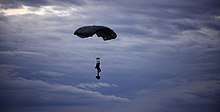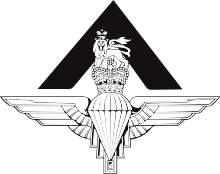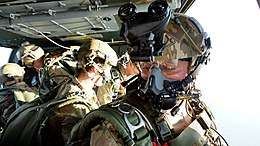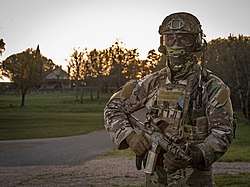Pathfinder Platoon
The Pathfinder Platoon is a pathfinder unit of the British Army, and an integral part of 16 Air Assault Brigade. The Pathfinder Platoon acts as the brigade's advance force and reconnaissance force. Its role includes locating and marking drop zones and helicopter landing zones for air landing operations. Once the main force has landed, the platoon provides tactical intelligence and offensive action roles for the brigade.[3]


| Pathfinders | |
|---|---|
 Logo of the Pathfinder Platoon | |
| Active | March 1985–present[1] |
| Country | |
| Branch | |
| Type | Airborne infantry |
| Role | Advance Force operations Special operations Reconnaissance |
| Size | 40 men[2] |
| Part of | |
| Garrison/HQ | Colchester, England |
| Nickname(s) | "The PF", "The Finders", "X Platoon", "Ghost Platoon" |
| Motto(s) | First In |
| Engagements | List
|
| Insignia | |
| Drop Zone Flash |  |
History
During the Second World War small groups of parachute soldiers were formed into pathfinder units, to parachute ahead of the main force. Their tasks were to mark the drop zones (DZ) or landing zones (LZ), set up radio beacons as a guide for the aircraft carrying the main force and to clear and protect the area as the main force arrive.[4]
The units were formed into two companies to work with the two airborne divisions. The 21st Independent Parachute Company served with the 1st Airborne Division and the 22nd Independent Parachute Company served with the 6th Airborne Division.[4] The 22nd Independent Parachute Company were amongst the lead elements of the 6th Airborne division's drop into Normandy as part of Operation Tonga.[5] While the 21st Independent Parachute Company took part in Operation Market Garden landing at Arnhem on the night 17 September 1944. After marking the DZs and LSs The Company was trapped with the rest of the division in the Oosterbeek Perimeter.[6]
After the war both companies were disbanded and in 1948, the army's parachute force was reduced to the 16 Parachute Brigade. Part of this reduction saw the formation of the No. 1 Guards Independent Parachute Company which became the pathfinder unit for the newly formed brigade.[7] The Company deployed on a wide variety of operations between 1948 and 1977. It was deployed to Borneo during the Borneo Confrontation where it was trained as a special reconnaissance unit.[8][9]
Following the 1982 Falklands War, 5 Airborne Brigade was established as a light, rapid reaction force for similar requirements. The brigade was formed from the two Parachute Regiment and one line infantry battalions and support units. The Brigade identified a requirement for an independent intelligence collection capability, deployable into a hostile or non-permissive environment ahead of the main force so in 1985 the Pathfinder Platoon was established with personnel drawn initially from the patrols platoon of each of the three Parachute Battalions. For many years it was not an officially established unit, being financed from other parts of the Brigade's budget.[10] In 1999, 5 Airborne Brigade merged with 24 Airmobile Brigade to form the present day 16 Air Assault Brigade with the platoon remaining attached to the Brigade headquarters.
Command, control and organisation
The platoon work under the command of the Brigade Headquarters in Colchester, Essex. The Officer Commanding Pathfinder Platoon is a senior Captain or Major with an Operations Warrant Officer (OPSWO) as his second in command. The platoon operates in teams of between 4–6 men. In 2006 a new rate of Parachute Pay (High Altitude Parachute Pay) was introduced for members of the Pathfinder Platoon following the recommendations of the Armed Forces’ Pay Review Body.[11]
Members of the platoon come from across the armed forces. The majority is made up of infantry soldiers and combat engineers the platoon has attached soldiers from the REME, Royal Signals and the RAMC.
Selection and training
Pathfinder Platoon Selection Course
Selection lasts for 6 weeks, the Pathfinder Platoon Selection Course, also known as 'The Cadre' covers almost all UKSF Selection Course training grounds although it is much shorter. The Cadre consist of:[12][13]
Phase 1 – Aptitude Phase (1 week)
Candidates need to complete:
- 8 miles (13 km) speed march, two times
- 10 miles (16 km) speed march
- 2 miles (3.2 km) march in full equipment
Candidates are taught basic navigation and signal skills in between the physical exercises.
Phase 2 – Navigation Phase (1 week)
Also known as Hills Phase, candidates need to complete:
- 26 kilometres (16 mi) tab over the hills of Brecon Beacon
- 24 kilometres (15 mi) tab across Black Mountains
- 40 miles (64 km) march
Phase 3 – Standard Operating Procedure (SOP) Phase (1 week)
Candidates will be trained with:
- Basic Patrol skills
- Contact drills
- Helicopter procedures
- Construction of concealed Observation post (OP)
Phase 4 – Range Phase (1 week)
Also known as Live firing Phase, this phase takes place on Sennybridge Training Area (SENTA). The candidate will be trained with:
- Focused contact drills
- Man-down drills
- Basic demolition
At the end of Phase 4, candidates will participate in a platoon-sized live assault.
Phase 5 – Final Exercise (2 weeks)
Candidates will be teaming up with a 4-6 men team and tasked with planning and execute a typical reconnaissance mission. Candidates will be captured and need to go through series of mock interrogations by the instructors. Candidates are tested physically and mentally.
Operations


The present day Pathfinder Platoon has taken part in operations in Yugoslavia, Sierra Leone, Macedonia, Afghanistan and Iraq.[14]
In June 1999, they were part of Operation Agricola in Kosovo. The platoon provided reconnaissance and the forward air control of air assets, behind enemy lines, for NATO command several days prior to the main land offensive. Once NATO forces had entered Kosovo, the platoon were re-tasked to provided a defensive screen around Pristina International Airport prior to the arrival of the Russian forces.[15]
Their next operation was Operation Palliser in Sierra Leone. The platoon deployed into Freetown on May 7, 2000 to assist the UNAMSIL efforts. Deployed around Lungi under the command of Sergeant Stephen Heaney, they were engaged by a Revolutionary United Front (RUF) force trying to capture the airport. The platoon, outnumbered 20 to one, fought throughout the night and repulsed the RUF, which suffered 20 dead without any loss to the platoon. For his actions during the engagement Heaney was awarded the Military Cross.[16][17]
In 2001 the Pathfinder Platoon deployed for Operation Essential Harvest in the Republic of Macedonia supporting the Special Air Service in mapping the National Liberation Army (NLA) positions.[18]
The Platoon was deployed to the southern Afghan province of Helmand alongside the 3 Para Battle Group in 2006. The Pathfinders spent 52 days in the town of Musa Qal'eh and were engaged in fighting the Taliban for 26 of the 52 days.[19]
By May 19, the Pathfinders joined the Afghan National Police (ANP) in a counterattack in Taliban held territory. From there, a US B-1 Lancer bomber and A-10's were directed by PF Forward Air Controllers (FACs) onto Taliban positions. They were then supplemented by French Super Etendards from the Charles de Gaulle aircraft carrier in the Indian Ocean. The men then set out on a four-day mission to a town in the north of Helmand province in Afghanistan ended up spending 52 days under siege by the Taliban. 25 men, who have been first into several Taliban-held areas during the British deployment in southern Afghanistan, came under such ferocious attack that they were forced to stay in Musa Qala fighting almost daily battles. The group was supposed to be reinforced by a company of 120 paratroopers but they had to be diverted to the town of Sangin when they came under heavy assault by Taliban insurgents. The platoon were finally replaced in Musa Qala when 500 British troops, in a mission codenamed Operation Snakebite broke through Taliban lines.[20]
In 2010 the Pathfinders deployed again to Helmand Afghanistan as the Brigade Reconnaissance Force operating throughout Helmand Province conducting reconnaissance tasks and offensive action tasks. During the course of this tour an attached soldier Pte John "Jack" Howard (3 Para) was killed in action[21] during a strafing run from an American Close Air Support mission.
| Operation | Country | Year |
|---|---|---|
| Operation Agricola[14] | 1999 | |
| Operation Palliser[14] | 2000 | |
| Operation Essential Harvest[18] | 2001 | |
| Operation Herrick IV[19] | 2006 | |
| Operation Herrick VIII[22] | 2008 | |
| Operation Herrick XIII[19] | 2010 | |
In popular culture
Books
- Kent, Ron (1979). First in!: Parachute Pathfinder Company: a history of the 21st Independent Parachute Company. B.T. Batsford. ISBN 0-7134-2199-1.
- Shortt, James; McBride, Angus (1981). The Special Air Service. Osprey Publishing. ISBN 0850453968.
- Gberie, Lansana (2005). A dirty war in West Africa. Indiana University Press. ISBN 0253218551.
- Blakeley, David (2013). Pathfinder: A Special Forces Mission Behind Enemy Lines. Orion. ISBN 1409129020.
- Blakeley, David (2014). Maverick One. Orion. ISBN 1409146634.
- Heaney MC, Steve (2015). Operation Mayhem. Orion. ISBN 1409148459.
- Heaney MC, Steve (2016). X Platoon. Orion. ISBN 1409148505.
Television
References
- "The Formation of Pathfinder Platoon For 5 Airborne Brigade". Airborne Assault: ParaData. Retrieved 2 September 2018.
- Della-Ragione, Joanna (1 June 2012). "Revealed: Britain's secret soldiers". Sunday Express.
- "Fact file: 16 Air Assault Brigade". BBC News. February 26, 2003. Retrieved April 7, 2010.
- "21st Independent Parachute Company". Paradata. Retrieved April 7, 2010.
- Chester Wilmot. The Struggle for Europe. Wm Collins and Sons Ltd. p. 251.
- "Obituary,Lieutenant-Colonel Bill Barclay". Daily Telegraph. London. February 2, 2010. Retrieved April 8, 2010.
- "No 1 (Guards) Independent Parachute Company". Paradata. Retrieved April 10, 2010.
- Shott & McBride, p.24
- "No. 1 Guards Independent Parachute Company". Paradata. Retrieved April 10, 2010.
- Defence of the realm:Phantom Platoon (BBC, 1996)
- "Armed Forces' Pay Review Body THIRTY-FOURTH REPORT 2005" (PDF). Archived from the original (PDF) on 2009-09-03.
- "The Pathfinder Platoon". Boot Camp & Military Fitness Institute. 8 August 2016. Retrieved 2 September 2018.
- "The Pathfinder Platoon". UK Elite Forces. Retrieved 2 September 2018.
- "Obituary,Corporal Bryan James Budd killed in Afghanistan". Ministry of Defence. Retrieved April 8, 2010.
- "MOD Briefing, 17 June 1999". Archived from the original on 29 September 2007.
- Gberie, p.173
- Smith, Michael (April 6, 2001). "No medal for SAS man killed in hostage rescue". Daily Telegraph. London. Retrieved April 9, 2010.
- Smith, Michael (August 20, 2001). "Macedonian war is over, pledges rebel leader". Daily Telegraph. London. Retrieved April 9, 2010.
- "Coming home: 3 Para Battlegroup talk about their battle with the Taliban". Ministry of Defence. Retrieved April 9, 2010.
- "British troops in 5day chase of Taliban". The Times. London. May 28, 2006. Retrieved May 21, 2010.
- "Private John Howard killed in Afghanistan". Ministry of Defence. Retrieved 9 May 2018.
- "16 Air Assault Brigade To Replace 52 Infantry Brigade". Ministry of Defence. Retrieved April 8, 2010.